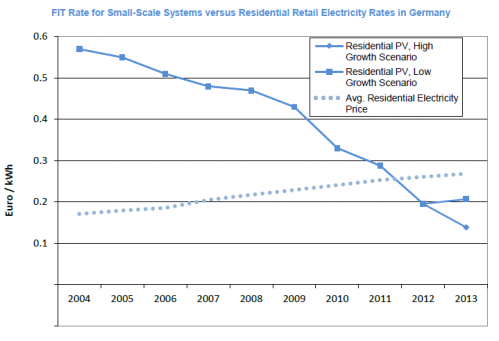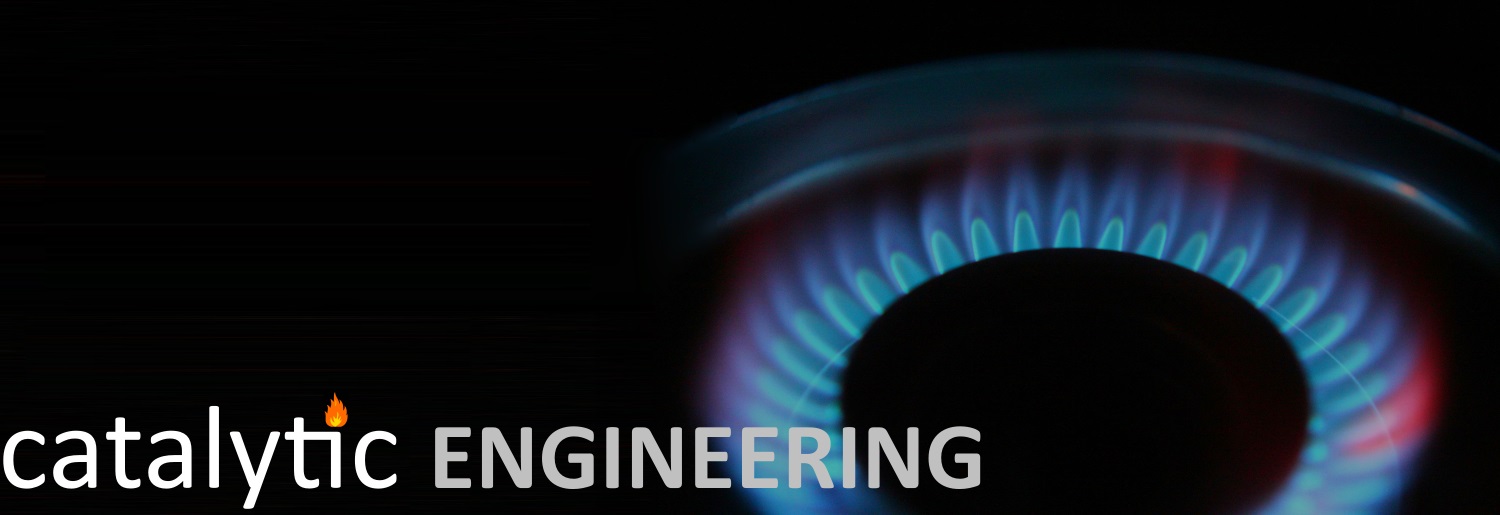image credit (C) Ralph Larmann for the LICHTGRENZE project, tracing the path of the Berlin Wall in light – used with permission
By Bruce Lin with Matthew Klippenstein
We continue our analysis of Tesla’s stationary energy storage business with a closer look at the German residential market, and provide a tool for you to try your own numbers. (Part 1 is here).
First, Danke to Germany for catalyzing the growth of solar PV through its feed-in tariffs and driving panel costs down for the rest of the world. As PV prices have come down, the feed-in-tariff that panel owners earn for selling solar power to the grid has also declined from over €0.50/kWh in 2000, down to about €0.11/kWh today (residential small-scale).
That’s far below Germany’s relatively high average residential purchase price of €0.29/kWh, which includes a variety of grid charges, including the shared cost of those earlier feed-in tariffs. The feed-in-tariff is scheduled to shrink further over time, and a new auction scheme may drive it down even further. (German Energy Blog has a good summary of the relevant policy).
If storage helps you buy less electricity from the grid – effectively raising the value of your solar electrons from €0.11/kWh to €0.29/kWh — could this be the perfect application for Tesla’s Powerwall?

Chart of decreasing Solar PV FIT from Deutsche Bank Climate Group, used with permission
Key Assumptions
We run the numbers in a simple cost payback model. Here are our default numbers and assumptions:
- The solar panel is sized so you have enough surplus power to store 7kWh of power in the Powerwall, 365 days a year.
- The system efficiency assumptions are 92% round-trip DC-DC as specified by Tesla; 97% one-way inverter efficiency in going from solar DC to the grid AC; and effectively 100% efficiency in going from the solar panel DC output to the DC-DC converter’s input (this is one big advantage of having the DC-DC converter)
- You sell power back to the grid at a fixed rate of $0.12/kWh, and buy from the grid at a fixed rate of $0.34/kWh (no time-of-use pricing).
- The 7 kWh DC rating is for discharge and you can consume all the discharged energy every day
- Discount rate of 3%
- The Powerwall maintains its efficiency and capacity over its entire 10-year lifetime.
- The Powerwall costs $3,000 plus $1,500 of taxes and installation cost, and is fully compatible with the existing solar inverter.
Companies often set warranty terms to ensure that fewer than 2 percent of units fail within the warranty period. If Tesla is using a similar strategy, fully 98 percent of Powerwalls may still be operating in year 11, and many units for years beyond that. To simplify things, we’re assume that the probably-longer-than-ten-year life balances out whatever derating the product might suffer under daily cycling.
See the footnote for other, more detailed assumptions. These inputs go into our calculator below, and we’ve made it open so that you can try your own numbers:
Great thanks to Omari Stephens for coding the Javascript calculator – any errors are the authors’ and not his.
Results:
Our test case is where you have the solar panel and buy a Powerwall, store 7 kWh DC of surplus solar energy per day, then self-consume it as AC electricity (6.79 kWh AC after inverter losses). This means every day, you buy 6.79 fewer kWh AC from the grid at the higher $0.34 price. This earns a net present value of $2,816 over 10 years (in constant 2015 dollars). Levelized cost of energy is $0.18/kWh, which is just the cost of the battery amortized over its life – the solar energy input is “free”. Positive net present value means you get a return, but it needs to be compared against the alternative.
That means the baseline case, where you already have the solar panel, but don’t buy the Powerwall. As a result, you sell that surplus solar power directly to the grid at the $0.12 rate. After currency exchange and this earns a net present value of $2,911 over 10 years (again, in constant 2015 dollars).
The difference is so small with these assumptions, that buying the Powerwall basically breaks even versus not buying one. As prices come down and installers compete to install the product, it looks to be even more viable on a purely economic basis. Add to that the benefits of having backup power and it starts to look like a good buy for consumers. (You can also add additional Powerwalls to increase return, but the model is valid only if you have enough surplus solar to fully cycle them every day of the year, and if you can consume all the stored energy).
This is different from the American peak shaving case in our previous article. In that one, a battery and inverter were being added to a house with no pre-existing solar panel or inverter, increasing cost. On the revenue side, PG&E Time-Of-Use pricing is only available during summer months, Monday to Friday, so the opportunities for savings are much smaller.
Conclusions
Tesla’s Powerwall $350/kWh (DC) price is a huge step forward, which our calculations show already make sense for some homeowners in places like Germany, as long as installation costs are reasonably low, they own fairly large PV arrays, and are in the relatively sunny parts of the country.
We rarely buy things for strictly economic reasons – Germany’s early adopters, like early adopters everywhere, may be even more motivated by interest in new technology, a drive to improve their household resilience and autonomy, and/or that universal human desire: to really stick it to their utility.
Next up, we’ll evaluate the Powerwall in the Hawaiian context, where conflicts between the local utility and would-be home solar installers is reaching volcanic proportions.
Catalytic Engineering is well-positioned for these sorts of assessments and we’re available for more detailed analysis, competitive intelligence reporting, engineering due diligence projects, etc. in batteries and other system engineering projects – please get in touch at info@catalyticengineering.com
Footnote: detailed assumptions
- Our default numbers imply the solar panel is grossly oversized in the summer, and that German winters are sufficiently sunny.
- The actual Euro prices are €0.11/kWh feed-in-tariff, and €0.30 purchase price, at $1.12 per Euro (May 12 2015 exchange rates)
- The discount rate of 3% is quite low but possibly appropriate for homeowners. Investors and companies would typically have a much higher discount rate, requiring better return from their capital investments.
- Though the battery’s energy storage capacity will slowly decrease over time, we discussed in Part 1 why we thought the Powerwall was oversized to deliver the promised capacity.


Here’s a very interesting comment from PV-Magazine about the Powerwall’s inverter requirements
http://www.pv-magazine.com/news/details/archive/2015/may/beitrag/tesla-powerwall-battery-coming-to-germany-in-q4_100019465/#axzz3aEQEQlGF
I’ve found your article via hacker news. It’s very interesting, but I
think you seriously overestimate the potential. The problem is the
consumption load curve. With some first calculations I get even with a
ridiculous 100 kW PV field an average of about 3 kWh per day of cycle
amount (energy stored and withdrawn) for a household with 10 kWh/day
consumption.
I’m doing my Phd about this area and have written a tool to generate
consumer load profiles to do these calculations. If you are interested
in doing a more detailed analysis, the tool is under
http://loadprofilegenerator.de/
It’s completely free. My interest is only getting bug reports.
Hi Noah,
I started my PhD as well and your tool sounds interesting I will have a look at it.
What is your PhD topic?
Kind regards,
Vincent
Great comments Noah. I’m very interested in the solar energy generation, and household consumption parts of that model. It seems to me that as long as you have an extra 7 kWh sometime during the day (due to supply-demand mismatch) you can make the required return. But it might be very difficult to achieve that in the winter, for example.
Your model looks like the perfect tool for this – would you be able to share data or a chart of typical household usage with surplus energy and grid consumption?
(edit: over one day for example?)
Bruce, I’ve done some simulations for an average family and posted the results here:
http://loadprofilegenerator.de/energy-arbitrage-potenial-of-a-7-kwh-battery-for-an-average-german-household/
You are completely right about the demand-supply-mismatch, the problem is just that this mismatch occurs a lot less than you might think. And I didn’t even include summer vacations in this simulation. If the family goes away for 3 weeks in August, it’s getting even worse.
Interesting calculator. However, I think your conclusion is
Interesting calculator. However, I think your conclusion is wrong. Your conclusion is that the PowerWall doesn’t make sense in Germany because it shows a small loss after 10 years. The problem with that is that the PowerWall is designed to last longer than 10 years, as it is rated for 5000 cycles. Tesla guarantees it for 10 years or 3650 cycles, but if it lasts 11 years, the calculator will show a profit of $278.26. If it lasts for its full rated lifetime of 5000 cycles or 13.7 years, it will show a profit of $1,232.18.
Also, if you have a large solar panel array and need 2 or more PowerWalls, your profit will be much larger since you won’t need to pay for the installation twice. Let’s assume that for two PowerWalls, the costs are $6000 plus $2000 for installation and taxes, and now you have 14 kWh, and the calculator shows a profit of $810.38 over 10 years, and over 13.7 years it shows a profit of $3,464.36. Imagine how much you would make if you bought 3 or more PowerWalls.
Please edit your blogpost to acknowledge this fact, as it will show that you are being fair with the calculations presented.
Hi Tech Talker, thanks again for your comments.
Actually, I think that it basically breaks even after 10 years – the cost difference of -$90 is small enough to be “in the noise” compared to the assumptions. And the discount rate means you’re actually earning a 3% (nominal) rate of return over the 10 years, which isn’t too bad in our current low-interest environment.
We do point out in the article that longer lifetimes mean more profit. I wouldn’t necessarily count on exceeding the warrantied life, but the upside is there.
As for multiple Powerwalls, it’s not that simple for the European case because you have to consume all the self-stored power to “earn” the €0.30/kWh avoided cost. If you have too many Powerwalls, and end up with surplus energy, the best you can do is sell it back to the grid at the low FIT price of €0.10/kWh, which definitely doesn’t make money.
It’s a bit too complex for our basic calculator here, but more sophisticated modelling of household demand and solar supply would show the maximum amount of storage that makes sense. See the link from the German researcher above, for example. It’s possible some Germans already aren’t consuming enough energy to justify a single Powerwall.
Here’s UBS’s take on it, claiming 9% IRR in Australia. I don’t have access to the original research note. They make even more aggressive assumptions:
– A$0.51/kWh avoided purchase price
– A$0.06/kWh FIT sale price
– 4.5 kWh cycled per day (approximate)
– A$5175 all-in purchase price including installation, Powerwall, and new inverter.
– 2.5% per year increase in electricity prices
That massive split in prices seems incredible, as some of the commenters on reneweconomy.com.au point out. I think the inverter price is unreasonably low but on the other hand, if you already have the right inverter in your solar system, the cost of that is zero.
The big question is whether your solar panel and home consumption is sized exactly right to generate a spare 5 kWh every day, and then consume that 5 kWh every day.
http://reneweconomy.com.au/2015/ubs-tesla-powerwall-can-deliver-6-year-payback-in-australia-63386
[…] Is the Tesla PowerWall battery system a worthwhile investment? […]
I my case the battery would not be worth installing. I am getting 0.17 EUR for every kWh I feed into the grid. Also, in the winter I get less than 3 kWh/day of energy from the panels on average: http://solarpi.tafkas.net
[…] American residents can now explore that question, thanks to a Powerwall cost calculator created by Bruce Lin and available on his Catalytic Engineering […]
[…] recent post at the Catalytic Engineering blog examines the 7kWh powerwall product for Germany and how it could be a perfect fit due the frugal […]
Agreed, solar is definitely moving forward with huge advancements in technology, and with the introduction of new organic fuel concepts – the future of solar is very bright. The only downside is the size and cost – however both of these issues will see solutions within the next 3-5 years, guaranteed. PV panels and AIO home hubs is where we should be focusing our efforts on!
Has anyone taken into consideration the US Federal Tax Credit of 30% on the PowerWall on their calculations?
The American federal tax credit isn’t in our assumptions above, but you can simulate it by putting in a reduced cost of the battery and installation. Definitely helps the economic case significantly.
There are some details about reducing the tax credit by the proportion of energy stored that comes from the grid, rather than the sun – see
http://www.renewableenergyworld.com/articles/2013/04/irs-confirms-that-batteries-qualify-for-the-energy-tax-credit-but-imposes-limitations.html
[…] on the island. This is 3X the mainland price and even higher than the typical German pricing in our last article. However, the case for energy storage is mainly about regulations and grid stability, rather than […]
. For me solar energy isn’t even about a break even point or cost savings, it’s about gathering electricity every day essentially, with no fuel or moving parts. A car is a big investment what with insurance, registration, inspections, car cost, gas, maintenance and so on. What return do we get from our car invstment in dollars and cents? Pretty much zero! With solar after the initial costs are made it just chugs along carefree. Not everything can be broken down in a return investment scenario. If that were the case most of us would never buy anything. Go solar and make electricity whenever photons are streaming about, works for me.
Some interesting comments by Elon Musk at the recent Tesla AGM:
That’s an improvement. Musk added that the ‘daily’ Powerwall will output 5kW continuously, with 7kWhr capacity. Cost has increased to $3,500 + $500 installation for those who already have a solar installation and inverter.
Actually, it is not clear if the price and capacity refer to the 7kWhr or the 10kWhr, but the installed cost is $4000 for those having an inverter.
[…] Pour aider les utilisateurs à savoir si le jeu en vaut la chandelle pour eux, Bruce Lin, un ingénieur, a conçu un calculateur de retour sur investissement sur son blog Catalytic Engineering. […]
Awesome post. 2 questions:
– as far as I can tell you didn’t account for reducing FIT – although it seems stable since you did these calculations, if it further declines it makes more economic sense to store and use then sell back to the gird.
– can you update this for the new powerwall with included inverter? Also charging a car via DC would be nice to include – that’s an efficiency gain on both ends, right?
I have noticed you don’t monetize catalyticengineering.com, don’t waste your traffic,
you can earn additional cash every month with new monetization method.
This is the best adsense alternative for any type
of website (they approve all websites), for more info simply
search in gooogle: murgrabia’s tools